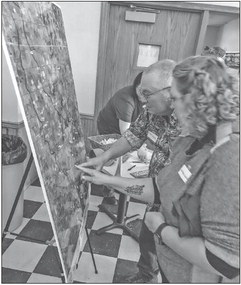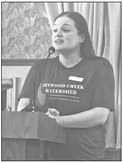Watershed residents learn about land conservation


Last week, about 140 residents of the Fenwood Creek Watershed were treated to a free meal and a bevy of information about how to keep their soil healthy and prevent phosphorus and sediment from contaminating local waterways.
Held at The Country Aire restaurant and hosted by Marathon County Conservation, Planning and Zoning (CPZ), the April 11 event gave farmers and other landowners a chance to hear from a variety of government agencies, non-profits and private companies about incentives for land conservation and services available to implement sustainable farming practices.
The gathering was part of the Fenwood Creek Pilot Project, a county-led effort to substantially reduce phosphorus runoff and soil erosion within the watershed, which encompasses roughly 25,000 acres of mostly farmland that flows directly into the Big Eau Pleine Reservoir.
County conservationist Kirstie Heidenreich greeted the audience and gave them an overview of the pilot project, which offers cost-sharing programs to farmers so they can implement environmentally friendly practices such as planting cover crops and establishing no-till setbacks along waterways. She noted that a survey of 300 landowners taken last year shows broad support for enacting changes to protect the land and water.
According to Heidenreich, four out of five surveyed residents are “very concerned” about the health of the watershed, and the same number also believes there are health and economic benefits from cleaning it up. She also said that 62 percent of respondents believe that sustainable agricultural practices can be profitable.
Heidenreich said the survey revealed that most landowners aren’t aware of the opportunities available for adopting sustainable agriculture, but they are willing to learn more. At the same time, she said they prefer smaller, voluntary changes introduced over time rather than “a bunch of new rules right away.”
“We’re saying, ‘Let’s do this voluntarily. Let’s all try to fix the watershed on a volunteer basis for those who are interested so we don’t have to come up with a new set of rules to improve water quality,” she said. “We believe we can do it through teamwork together.”
The pilot project’s goals are “lofty,” she said, as it seeks a 25 percent reduction in phosphorus runoff within two years, and a 90 percent reduction after 10 to 15 years. She said the county is marshaling all of its resources to achieve these goals.
“We will do the heavy lifting for you,” she told the audience. “All it takes is for you to connect with us, and we’ll help you get there.”
The event consisted of nine “lightning-round” presentations, each lasting about five minutes or so, from entities dedicated to soil conservation and water quality.
Heidenreich opened with a rundown of costsharing programs available through CPZ, focusing on nutrient management planning. In the Fenwood Watershed, she said about 8,400 acres, or 577 farm fields, are currently under nutrient management plans, which ensure that farmers are keeping their crops wellfed without overapplying manure and other fertilizers. The county is introducing no-cost nutrient management planning for farmers in the Fenwood Watershed, which includes cost-sharing of up to $750 for collecting and analyzing soil samples. County staff will collect the soil samples themselves, she said, and two certified crop advisors at the CPZ are available to write nutrient management plans for free. Most agronomists charge at least $2,000 for these plans, but the costs can be substantially higher based on the farm size.
“Some of you may have had to pay this bill in the past, and it is painful,” she said. “We want to remove that pain for you.”
After a nutrient management plan is in place, the county will offer $25 per acre for planting cover crops, $18.50 per acre for no-till or reduced till cultivation, $13 per acre for strip cropping and $9 per acre for contour farming. Multiple practices can be used at once, she noted, and farmers can “mix and match” services offered by other groups.
Cost-sharing is also available for a number of other activities, including stream-bank protections, grassed waterways, grazing and fencing, wetland restoration, barnyard improvements, and buffer strips. She said one of the main goals of the pilot project is to create a vegetative barrier between the land and water, and the county is willing to pay money to make that happen.
“We would love to come out to your property and talk to you about some really cool options that may work for you,” she told the audience.
Other speakers included:
n Amy Neigum of the USDA’s Natural Resource Conservation Service said the federal agency offers technical advice and assistance on a voluntary basis. She listed a variety of programs that promote conservation practices and said the NRCS also maintains an updated soil survey with important information for farmers.
n Tricia Verville of the Sand County Foundation said the non-profit group uses “performance-based conservation strategies” to mitigate phosphorus and soil loss on farms. She mentioned “prairie strips,” contoured areas of native grass and flowering plants that can slow down water flow and allow sediments to be filtered out before it enters the environment. The strips take up less than 10 percent of a farm field, but they can reduce sediment loss by 95 percent and phosphorus runoff by 85 percent, she said.
n Heather Doherty, a Farm Bill biologist and member of Pheasants Forever, said she works mostly with wildlife habitat, but she also does on-farm visits and provides connections to programs that can help make land improvements. She also supports grazing efforts and is involved in prescribed burnings to promote the growth of native plants.
n Claudio Gratton of UW-Madison spoke about the Grassland 2.0 project, which aims to restore some of the original, perennial grasslands of Wisconsin that “built the soils upon which a lot of our agriculture is actually based.” He said agriculture can be part of the solution, pointing to a farm in the Driftless Area that uses rotational grazing and has a Class 1 trout stream running through it. However, he also showed pictures of water near Madison that looks like pea soup and is unfit for swimming in.
Gratton went through a couple of computer simulations showing what could happen to water quality within the watershed if specific changes were made. He said the farms along the Fenwood Watershed currently release about 70,000 pounds per year of phosphorus into the environment, so it’s going to take a “major effort” to meet the longterm goal of 90 percent reduction.
n Brooke Bembeneck, a conservation specialist with CPZ, spoke about the Eau Pleine Partnership for Integrated Conservation (EPPIC), a communitybased group dedicated to improving the health of the Big Eau Pleine, through outreach and education events such as field days, where farmers can share best practices for improving soil and water quality. EPPIC also offers incentives that act as “a stepping stone” toward government programs.
n Matt Oehmichen of Short Lane Ag Supply said his family’s company offers custom seed mixes and promotes cover cropping and inter-seeding. He said they rely on their network of knowledgeable customers to come up with the best crop production and grazing practices – all with an eye on soil health and conservation.
“It’s all about leaving a legacy on your land,” he said. “It’s about field productivity, it’s about making yield and it’s about maximizing the effort of that field.”
n Jason Cavadini, a grazing specialist for UW-Extension, said grazing practices have become significantly more popular in the last decade, as farmers have become increasingly interested in soil health. He said managed grazing is important for making sure farmers maximize the benefits of their land and livestock. As an example, he mentioned a farm in Door County that puts 100 heifers out onto the fields for 180 days per year, saving $270 per head, or $27,000 a year.
n Jeremy Williams, owner of American Drone, spoke about his company’s use of unmanned aerial vehicles to spread seeds, including those for cover crops, without problems such as soil compaction and crop damage.

Kirstie Heidenreich
